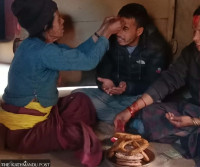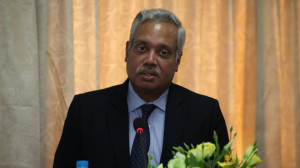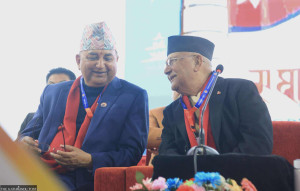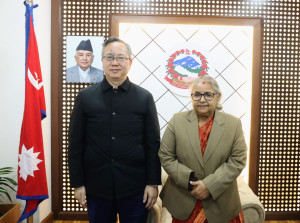National
100 days, and still no justice for Nirmala Pant
Four things stand out as investigations into the horrific rape and murder of Nirmala Pant make no headway on the 100th day since the 13-year-old went missing on July 26—lapses in DNA tests, conclusion of the post-mortem report that the girl’s vocal cord was broken, the lost CCTV footages of the nearby Hotel Opera, and the Army barracks close to the crime scene.
Arpan Shrestha & Nayak Paudel
Four things stand out as investigations into the horrific rape and murder of Nirmala Pant make no headway on the 100th day since the 13-year-old went missing on July 26—lapses in DNA tests, conclusion of the post-mortem report that the girl’s vocal cord was broken, the lost CCTV footages of the nearby Hotel Opera, and the Army barracks close to the crime scene.
The National Human Rights Commission (NHRC), which is investigating the case separately, released a statement last month, directing the police to preserve the vaginal swab of the victim while ordering the Mahakali Zonal Hospital to report the process followed while collecting the sample for DNA analysis.
The commission also directed the government to retest the DNA of all suspects and evaluate the overall laboratory process for any lapses but the government has “shockingly shown no response at all”.
Read: Family mourns, and a country recoils at teen girl's rape and murder
“These are strong directives. If followed, it will benefit the government and make it more credible,” NHRC member and Spokesperson Mohna Ansari told the Post.
“The post-mortem report did not come out of the due process. The report is incomplete. You can sense that there is an intention to conceal and there have been serious lapses from the very beginning.”
Details of the crime scene, citizen video of police officers tampering with what could have been forensic evidence, protests and rallies and the high drama of multiple probe committees that followed often overshadow the autopsy conclusion that the culprit broke the girl’s vocal cord, which resulted in her death and the authenticity of the DNA tests.
“Police officers tampered with the evidence at the crime scene. The same officers took the body for autopsy. How can we believe if the semen sample is real?” Collective Campaign for Peace representative and activist Sharada Chand, who has been campaigning along with Nirmala’s parents, told the Post.
In closed circles, it has also been pointed out that the manner in which the murder was committed is strong evidence that the culprit is not an average person. Early last month, the Human Rights Organisation of Nepal released its report, claiming that the Nepal Army barracks in Kanchanpur may have information about the crime.
“Our investigation hasn’t led us to the Army barracks so far but if we have any lead, we will pursue our probe,” DSP Krishna Raj Ojha, who currently leads the investigation in Kanchanpur, told the Post.
“The investigation should bring everyone from the immediate periphery of the crime scene under the scanner and hold them accountable. More so if it is a security organ. No one should be spared,” said Ansari.
On September 11, 41-year-old Dilip Singh Bista—a mentally challenged person presented as the main suspect—was freed after the DNA test results were negative.
Bowing to public pressure, the police carried out DNA tests of the then Kanchanpur Police chief SP Dilli Raj Bista, his son Kiran Bista and Ayush Bista, the nephew of Bhimdutta Municipality Mayor Surendra Bista. Their results were negative too.
DNA samples of nine more suspects, who face close scrutiny, have been collected after Ojha was assigned the case. Two investigation teams led by DSP Angur GC and SSP Thakur Gyawali have been recalled, suspended and are currently under the scanner of the probe team led by AIG Dhiru Basnyat.
“We are still not sure if the semen sample derived from the vaginal swab of Nirmala is real. If it is, Nepal Police can test hundreds of suspects but if it is fake, they should just end this drama,” women rights activist Lhamo Y Sherpa told the Post.
Following the Mainali probe committee’s report, the government sacked suspended SP Bista and Inspector Jagadish Prasad Bhatta. The Home Ministry says it awaits “new reports which will offer the case a new angle” but Nirmala’s parents and activists in Kanchanpur say their hope for justice is dying.
“The government’s action to sack Bista and Bhatta is also questionable because they are still eligible to hold government jobs in the future and may join Nepal Police again. The government is just trying to quell the protests,” said Sherpa, adding that the government, which should have been proactive, acts only after people take to the streets.
The Home Ministry had cited Clause (1) of Sub-rule (2) of Rule 109 of the Nepal Police Regulations-2071 BS, which holds that the sacked officers qualify for government services in future.
On July 26, the day before Nirmala’s body was found, suspect Kiran Bista, son of the now sacked SP Bista, had thrown a birthday party at Hotel Opera, three kilometres from the crime scene.
The hard disks of the CCTV camera installed at the hotel were seized by the police, a month after the brutal incident, and are currently at the police headquarters for investigation. It is believed that the drives could offer key leads in the probe but chances of the footages being recovered are bleak. “The hard disks are under the process of recovery. We are trying to retrieve the deleted footages using the technologies we have. We are also consulting with our international sources,” Nepal Police Spokesperson SSP Uttam Raj Subedi told the Post.
It’s a full circle—the details of the crime scene, the video of the police tampering with evidence, the hurried post-mortem and cremation, protests and shootings which killed a teenager and injured dozens, investigation teams dispatched and recalled, and high-level commitments to nabbing and punishing the guilty, continue to make headlines. But the question remains: Who raped and killed Nirmala?




 18.12°C Kathmandu
18.12°C Kathmandu




.jpg&w=200&height=120)











